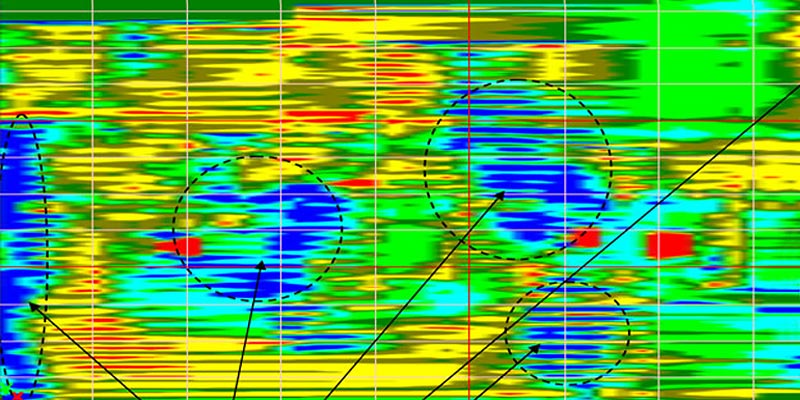This GPMR data analysis was designed to determine the existence and extent of sub‐grade erosion and voiding beneath the lower level structural slab-on-grade in a modern residential high-rise. The manner of investigation was to use non destructive ground penetrating microwave radar to three dimensionally image through the concrete slab‐on‐grade, to facilitate a high resolution data analysis of the sandy fill materials below.
Under the direction of consulting engineers, the scope of work undertaken consisted of imaging the sub-grade material between the structural footings and the floor slab-on-grade throughout the lower level. In addition, the column footing at the intersection of grids G and 6.5 was imaged in the same manner to analyze the sub‐grade materials around and below the 36” thick footing.
 Background Information:
Background Information:
The structure is a 26 story high rise condominium with below ground level parking. It is our understanding that a 3” ABS discharge line between grids F.5 and 6 was compromised and forced an unknown volume of water under pressure into the sandy sub grade materials below the existing structural slab. During trenching and remediation of the 3” ABS line it was discovered that the introduction of water under pressure below the structural slab had created significant erosion voids in the vicinity of the compromised line. The widespread extent of erosion voiding was unknown at that time and raised significant concern. On October 13th, 2011 GPR Data Inc. was retained on an emergency basis to investigate and determine the extent of probable widespread sub-grade erosion using non-destructive ground penetrating microwave radar.
Excerpt: Summary of GPMR Data Test Results:
During construction, sand was used as fill material to support the slab-on-grade. Earlier last year when water flooded the P4B level and saturated the sand, hydraulic pressure from the weight and volume of water being pumped away left the sandy material in a soft unconsolidated state containing large air vesicles nested between the particles of sand. This caused the fill sand to be become extremely unconsolidated in some areas. This condition was illustrated during ground proofing when the 1/2” metal probe was lightly pushed by hand through the sand crust and water proof barrier with little to no effort penetrating the soft unconsolidated material to depths of 60.00”. Normal compacted consolidated fill and fill sands would be densely bedded compact and difficult to probe even to nominal depths.
GPMR data throughout the level presents credible evidence of wide spread voidance and unconsolidated soft fill sands. Although widespread, the most dramatic voiding is largely concentrated around the sump basins. With the exception of these areas, voiding is largely observed within 2”-12” below the bottom of the slab-on-grade.
Resolution:
After the erosion voids were characterized, our client decided to inject grout and reestablish the integrity of the grade material, supporting the structural slab for its intended use. Using our X, Y, & Z dimensions and volume estimations, the proper amount of grout (28 yards) was obtained without additional expense from overpurchasing. Moreover, the injection process itself was streamlined, applying grout solely to the areas in need of reinforcement. Project costs were held to a minimum, and the structure was brought back into specification.

